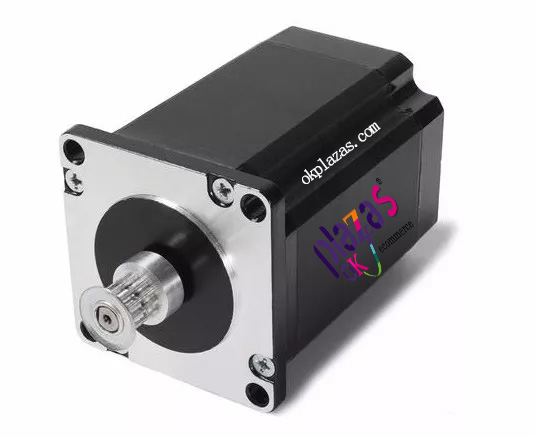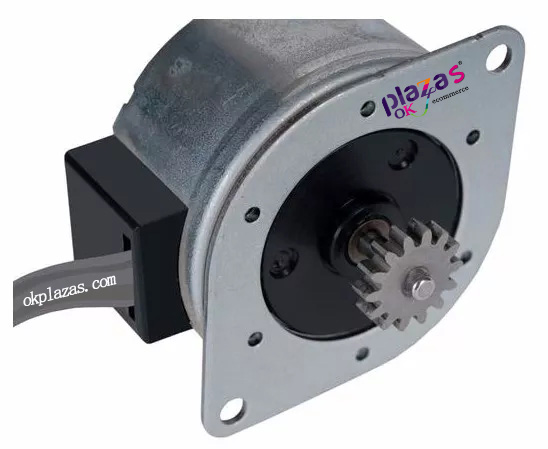【Industrial knowledge】Basic knowledge of servo
【Industrial knowledge】Basic knowledge of servo
1. What is servo? Why use a servo?
Servo system definition: A control system that realizes the output variable accurately follows or reproduces the input variable. The requirements for motion control are getting higher and higher, and servo control comes into being.
2. What is a servo motor? What are the characteristics?
Servo motor is also called executive motor. In automatic control system, it is used as an executive element to convert the received electrical signal into angular displacement or angular velocity output on the motor shaft. It is divided into two categories: DC and AC servo motors. Its main feature is that there is no rotation when the signal voltage is zero, and the speed decreases at a uniform speed as the torque increases.

The characteristics of the servo points are more clearly explained here compared with the stepper motor:
1. Different control accuracy
The step angle of the two-phase hybrid stepping motor is generally 3.6°, 1.8°, and the step angle of the five-phase hybrid stepping motor is generally 0.72°, 0.36°. There are also some high-performance stepping motors with a smaller step angle. For example, a stepping motor used in slow-moving wire machine tools produced by Stone Company has a step angle of 0.09°; the three-phase hybrid stepping motor produced by Berger Lahr can pass the step angle The DIP switches are set to 1.8°, 0.9°, 0.72°, 0.36°, 0.18°, 0.09°, 0.072°, 0.036°, which are compatible with the step angle of two-phase and five-phase hybrid stepping motors.
The control accuracy of the AC servo motor is guaranteed by the rotary encoder at the back of the motor shaft. Take Panasonic's all-digital AC servo motor as an example. For a motor with a standard 2500-line encoder, the pulse equivalent is 360°/10000=0.036° due to the quadruple frequency technology used inside the drive. For a motor with a 17-bit encoder, every time the driver receives 217=131072 pulses, the motor makes one revolution, that is, its pulse equivalent is 360°/131072=9.89 seconds. It is 1/655 of the pulse equivalent of a stepping motor with a step angle of 1.8°.
2. Different low frequency characteristics
Stepping motors are prone to low-frequency vibration at low speeds. The vibration frequency is related to the load condition and the performance of the drive. It is generally considered that the vibration frequency is half of the no-load take-off frequency of the motor. This low-frequency vibration phenomenon determined by the working principle of the stepper motor is very unfavorable to the normal operation of the machine. When stepping motors work at low speeds, damping technology should generally be used to overcome low-frequency vibration phenomena, such as adding a damper to the motor, or using subdivision technology on the drive.
The AC servo motor runs very smoothly and there is no vibration even at low speeds. The AC servo system has a resonance suppression function, which can cover the lack of rigidity of the machine, and the internal frequency analysis function (FFT) can detect the resonance point of the machine, which is convenient for system adjustment.
3. Different moment frequency characteristics
The output torque of a stepping motor decreases with the increase of the speed, and will drop sharply at a higher speed, so its maximum working speed is generally 300-600RPM. The AC servo motor has a constant torque output, that is, it can output a rated torque within its rated speed (generally 2000RPM or 3000RPM), and a constant power output above the rated speed.
4. Different overload capacity
Stepper motors generally do not have overload capacity. AC servo motor has strong overload capacity. Take the Panasonic AC servo system as an example, it has speed overload and torque overload capabilities. The maximum torque is three times the rated torque, which can be used to overcome the moment of inertia of the inertial load at the moment of starting. Because stepper motors do not have this overload capacity, in order to overcome this moment of inertia when selecting models, it is often necessary to select a motor with a larger torque, and the machine does not need such a large torque during normal operation, so a torque appears. The phenomenon of waste.
5. Different operating performance
Stepper motor control is open loop control. If the starting frequency is too high or the load is too large, it is easy to lose steps or stall. When the speed is too high, it is easy to overshoot. Therefore, to ensure its control accuracy, it should be handled well. Increase and decrease speed problems. The AC servo drive system is a closed-loop control. The drive can directly sample the feedback signal of the motor encoder. The position loop and speed loop are formed inside. Generally, there will be no step loss or overshoot of the stepper motor, and the control performance is better* .
6. Different speed response performance
It takes 200 to 400 milliseconds for a stepping motor to accelerate from a standstill to a working speed (generally several hundred revolutions per minute). The acceleration performance of the AC servo system is better. Take the Panasonic MSMA 400W AC servo motor as an example. It only takes a few milliseconds to accelerate from a standstill to its rated speed of 3000RPM, which can be used in control situations that require fast start and stop.

3. What are the types of encoders? What are the applications?
Encoders are instrumentation devices that compile and convert signals or data into signal forms that can be used for communication, transmission and storage.
1. Different classification according to the engraving method of the code disc: (there are many encoder classification methods, just talk about the commonly used classification)
(1) Absolute encoder: There are several concentric code discs along the radial direction on its circular code disc, and each track is composed of light-transmissive and opaque sectors. The sector trees of adjacent code tracks It is a double relationship. The number of code channels on the code disc is the number of binary digits. On one side of the code disc is the light source, and on the other side there is a photosensitive element corresponding to each code channel. When the code disc is in different positions, Each photosensitive element converts a corresponding level signal according to whether it receives light or not to form a binary number.
(2) Principle of incremental encoder: every time the shaft rotates through a specified unit angle, it sends out a pulse signal (also sends a sine signal, then subdivides it, and chopped to produce higher pulses), usually A, B , C three-phase output, A and B phases are mutually delayed by 4 cycles of pulse output. According to the delay relationship, the forward and reverse can be judged. By using the rising and falling edges of A and B phases, it can perform 2 times and 4 times frequency processing , Phase Z is a single-turn pulse, that is, one pulse is sent out every turn.
2. Classified by the mechanical installation form of the encoder:
(1) Shaft type Shaft type can be divided into clamping flange type, synchronous flange type, servo mounting type, etc.
(2) Bushing type: The bushing type can be divided into half hollow type, full hollow type and large diameter type.
Encoder application
Encoders are mainly used in CNC machine tools and mechanical accessories, robots, automatic assembly machines, automatic production lines, elevators, textile machinery, sewing machinery, packaging machinery (fixed length), printing machinery (synchronous), woodworking machinery, plastic machinery (fixed number) , Rubber and plastic machinery, drawing instruments, goniometers, convalescent radars, etc.
4. How to realize servo control?
1. Servo mainly relies on pulses for positioning. Basically, it can be understood that when the servo motor receives 1 pulse, it will rotate the angle corresponding to 1 pulse to achieve displacement. Because the servo motor itself has the function of sending pulses, so the servo Each time the motor rotates one angle, a corresponding number of pulses will be sent out. In this way, it corresponds to the pulse received by the servo motor, or is called a closed loop. In this way, the system will know how many pulses were sent to the servo motor and how many received at the same time The pulse returns, so that the rotation of the motor can be controlled very accurately, so as to achieve precise positioning, which can reach 0.001mm.
DC servo motors are divided into brush and brushless motors. The brush motor has low cost, simple structure, large starting torque, wide speed range, easy control, and needs maintenance, but it is easy to maintain (change carbon brushes), generate electromagnetic interference, and have requirements for the environment. Therefore, it can be used in common industrial and civil applications that are sensitive to cost. The brushless motor is small in size, light in weight, large in output, fast in response, high in speed, small inertia, smooth in rotation and stable in torque. The control is complicated and it is easy to realize intelligence. Its electronic commutation method is flexible, and it can be square wave commutation or sine wave commutation. The motor is maintenance-free, highly efficient, low operating temperature, low electromagnetic radiation, long life, and can be used in various environments.
2. AC servo motors are also brushless motors, divided into synchronous and asynchronous motors. At present, synchronous motors are generally used in motion control. They have a large power range and can achieve great power. Large inertia, low maximum rotation speed, and rapid decrease as the power increases. Therefore, it is suitable for low-speed and smooth running applications.
3. The rotor inside the servo motor is a permanent magnet. The U/V/W three-phase electricity controlled by the driver forms an electromagnetic field. The rotor rotates under the action of this magnetic field. At the same time, the motor’s built-in encoder feedbacks the signal to the driver, and the driver is based on the feedback value. Compare with the target value and adjust the angle of rotor rotation. The accuracy of the servo motor is determined by the accuracy of the encoder (number of lines).





